E-Postcard #3
from Our British Isles Holiday
9/16 to 10/3/2002
Hello Everyone,
The time since we have left Glasgow has been a time of contrasts, alternating between the rush of cities and the quiet of the country.
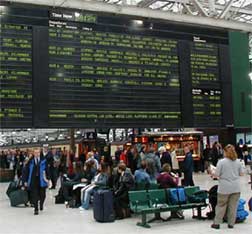
After Glasgow (and returning the rental car), we were off via train to the Lake District. Traveling by train and bus changes things for us. We can no longer leave half our stuff in the car when we stay somewhere. The little off road sites we would normally visit are now too far. Since we are overloaded (this includes the big backpacks, the little day packs, the food bag and the map bag), we try to minimize walking until we drop off our stuff. I’m still not sure what we over packed, but it does feel like I am washing out the same socks every night! Despite the load, we usually don’t have far to walk to get from hostel to train to bus, etc. The British mass transit system is well organized, on time, clean, and not very expensive. You can get to almost any little hamlet using the system, just not every ruin or historic site.
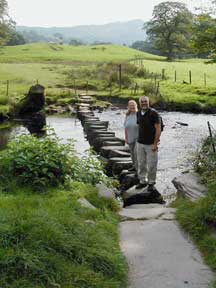
I remember learning in English lit class (many years ago) that William Wordsworth and other Romantic poets lived in the Lake District. My “romantic” mental image was of them walking paths through hill and dale, stopping to pen a few soon-to-be-famous lines as the scenery inspired them. Well, the scenery is certainly worthy of poetry. There are hills (almost mountains) with numerous footpaths; bucolic scenes of old stone farmhouses and sheep grazing on the slopes; and water varying from small streams to waterfalls to large clear lakes. However, if the poets were gazing starry-eyed at the scenery, they were soon flat on their face in the rocky path or rolling down a grassy hillside right by surprised sheep. In other words, some of the paths can be treacherous. They can contain rocks of all sizes that need to be stepped over or around. The streams need to be forded on shaky stepping stones (see attached photo). The sheep, horses, and cows also leave obstacles to be avoided. On one very narrow uphill path it was a steep drop on the left and very tall prickly thistles on the right. I was always looking down at where I was walking; only gazing up at the scenery when I stopped…..it was dangerous to do it any other way. Not to say it wasn’t fun or rewarding or inspiring; it just wasn’t relaxing. I wrote no poetry that day.
A word about the British public footpaths.
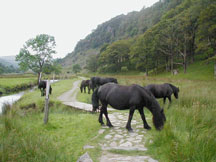 This is a nation of walkers. We see all ages walking alone or in groups, some with dogs, some with walking sticks, some bird watching, some looking for fossils, some with maps, and some just ambling along aimlessly. To all of them belong the public footpaths. These are usually marked paths of any distance. The paths, by law, can traverse private land (with permission).
This is a nation of walkers. We see all ages walking alone or in groups, some with dogs, some with walking sticks, some bird watching, some looking for fossils, some with maps, and some just ambling along aimlessly. To all of them belong the public footpaths. These are usually marked paths of any distance. The paths, by law, can traverse private land (with permission). 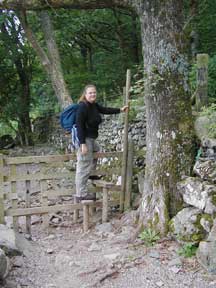 When a farm or grazing land is involved, there is usually a labeled gate that must be opened and closed or a stile (kind of ladder over a stone fence) that must be climbed. Some paths are shown on maps, others are well marked with wooden signposts, and still others are known only to the locals.
When a farm or grazing land is involved, there is usually a labeled gate that must be opened and closed or a stile (kind of ladder over a stone fence) that must be climbed. Some paths are shown on maps, others are well marked with wooden signposts, and still others are known only to the locals.
We have followed public footpaths between villages, around lakes, to a tea room in the hills, and up along a ridge. Most of these involved successful use of markers and maps. There was that one hike up to a scenic lookout, however. When we took the “shortcut” path back down, we must have missed the cues. As I was pushing my way through Diane-high ferns in the mud, I suspected we were lost. Tim, being taller, would just yell back, “We’re not lost, I can see the town.” I guess it didn’t matter that we had to climb a locked gate and stone wall (sans stile). I don’t think our footpath was public at all.
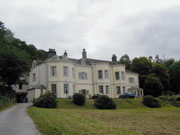
In the Lakes District we stayed in a hostel that was a mansion built in 1785 and overlooked a waterfall. The author Samuel Taylor Coleridge stayed here as a guest and complained that the bedrooms were too small, so the owner (who lived alone) put on an extension. (Coleridge wrote “The Rime of the Ancient Mariner,” poetry that would put me to sleep in any size bedroom.) The other Lakes District hostel was a former Georgian hotel overlooking Lake Windermere. We are sleeping in style at budget prices.
From the Lakes we went to Blackpool, the closest thing Britain has to Las Vegas. We would get the strangest looks from Brits when we mentioned we were coming here. It is essentially a seven mile long promenade with a large, old amusement park on one end.
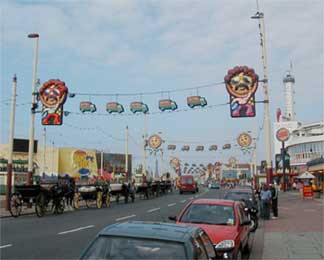 As you walk the promenade you pass endless small casinos, fast food places (fish and chips, not McDonalds), rock candy shops, souvenir shops, and hotels of all sizes. Rock candy, by the way, is a Blackpool favorite. It is a stick of candy about 1 inch in diameter, striped like a candy cane on the outside, with your name or other word through the center of the candy.
As you walk the promenade you pass endless small casinos, fast food places (fish and chips, not McDonalds), rock candy shops, souvenir shops, and hotels of all sizes. Rock candy, by the way, is a Blackpool favorite. It is a stick of candy about 1 inch in diameter, striped like a candy cane on the outside, with your name or other word through the center of the candy.
The Brits holiday here. Families come in the summer to enjoy the huge beach. Couples, groups of women (hen parties) or men (stag parties) come all year round for the pubs, dance clubs, and rather loud nightlife. During the autumn, the city has the Illuminations, commemorating the fact that Blackpool was the first British city with electricity. This is five miles of lit buildings and displays; everything from very old pictures formed by painted lightbulbs to laser light shows. There are smaller lit objects like shells, mermaids, fish, and alien spacecraft strung between every streetlight. Cars line up for miles to crawl down the main street; people are hanging out of windows or standing up through the sunroof. It is all delightfully tacky, bordering on tasteless. We enjoyed the display, but were happy to leave. Like Las Vegas, you either revel in it or you don’t. But it is certainly worth a visit if you want to taste all of Britain.
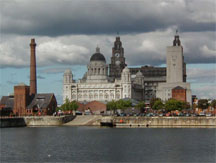
Then we went onward to Liverpool, determined not to visit all the highly advertised Beatle sites. Instead we visited two unique museums and two very different cathedrals. The Customs and Excise Museum had great displays on the kinds of illegal things people try to get through customs and how they are detected. The historical info on smuggling complimented the books we were reading at the time (Tim: “The New Forest” by Rutherfurd; Di: “A History of Scotland”). They showed how items can be seen on security scanners in airports and why certain people get targeted for baggage searches. The Conservation Museum was all about the technicians, craftspeople, and artisans that restore and preserve art and artifacts. There were displays on how a sculpture might get a missing part replaced, how a torn painting is repaired, how old paper is cleaned and preserved, and how a textile is restored (just to name a few). Like physicians, the art experts try to “do no harm”. Sometimes the best technique is to leave the art in its current condition. One display showed, by using x-rays, how an artist changed a painting over time. This was a fascinating place. The knowledge of chemistry, history, physics, and art were all intertwined. What a great place this would be to take our art students who don’t care to study science (and vice versa).
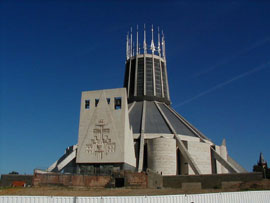
Liverpool has two major cathedrals. The Anglican cathedral was built within the last 50 years and made to look like the ancient Gothic cathedrals of Europe. It is a huge stone structure, architecturally interesting, but it had no soul. They used modern techniques to build something from the past. In contrast, the Metropolitan Cathedral (Catholic) was thoroughly modern. It was round with the main altar in the center. The center dome ceiling was made of stained glass. Tall narrow windows of stained glass were interspersed with beautiful wooden and metal sculptures and side altars. Despite the non-traditional design, we both could feel the warmth. A guide saw Tim taking photos and offered us a tour of the crypt, not usually open. Beneath the new church was the foundation for a traditional church, but construction stopped due to World War II. When the money was found to continue building, the design was radically changed (for the better). Tim says it is one of the most magnificent church he has ever visited. That’s saying a lot.
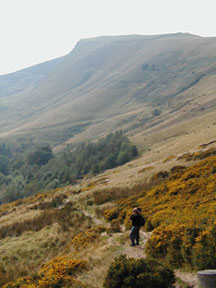
Not far away is the Peaks National Park, a contrast to the bustle of Liverpool city. We stayed at a 350 year old cottage in Castleton. Yes, there really is a castle (actually ruins) in Castleton, built in the 11th century by the son of William the Conqueror. And before him, the Romans hung out here. There are also huge caves in the hillsides. One housed a community of rope makers for the local lead mines. Another is the only source in the world for Blue John stone, a yellow/purple feldspar used primarily for jewelry. Castleton, itself, is my idea of the English village. The village green is surrounded by tea shops, old cottages, and a couple of pub/hotels. The streets are narrow and wind around each other. A stream runs through the village, bordered by stone houses which are crowded together but bright with window boxes. And towering over it all is Mam Tor (“mother of mountains”), a very high but walkable ridge that lets you see into two valleys. Photos don’t do this place justice. Two days here wasn’t enough.
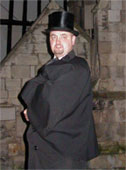
After picking up a car in Leeds (not really a memorable city), we headed to York. This is a walled town, with a long history of Roman, Viking, and finally English inhabitants. You can walk around on the walls and see lots of old (very old) buildings including a castle, fortress, and guildhall. We got free tickets to a ghostwalk, where a professional actor walked us around town at night telling stories of ghostly sightings and haunted places. Most of the big towns here have ghostwalks or dungeon tours. There is something about the macabre that brings out the tourists. York, because of its long history, is supposed to be the most haunted. I didn’t see any ghosts but the laundry room in the cellar of our hostel (mansion built in 1700s) was pretty creepy…maybe I was just hallucinating after several trips up and down from our third floor room. Or maybe it was centuries of dirty socks and underwear haunting the cellar.
The next few days saw us hopping about to see a odds and ends. On the eastern coast of England lies Robin Hood Bay (supposedly R.H. hid out here) and a small inlet called Boggle Hole.
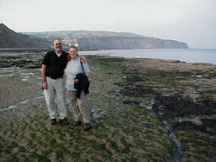 The hostel was a ¼ mile walk from the car park (parking lot) but worth every step. It would have been a perfect place to smuggle in goods way back when. At low tide you can walk the beach to the next village. At high tide, it is inaccessible. We then went north to spend Tim’s birthday walking Hadrian’s Wall. This was six foot thick wall with 12 foot ditch on both sides and lookouts built every mile. It marked the border of the Roman Empire and was built to keep the Scottish tribes in the north and the other brigands in the south. Much of the wall was used by locals for building after the Romans left, but there are still parts that go on as far as you can see. The hostel nearby was called Once Brewed, next to the pub called Twice Brewed. They say that a brew is an ancient term for a hill….hmmmm.
The hostel was a ¼ mile walk from the car park (parking lot) but worth every step. It would have been a perfect place to smuggle in goods way back when. At low tide you can walk the beach to the next village. At high tide, it is inaccessible. We then went north to spend Tim’s birthday walking Hadrian’s Wall. This was six foot thick wall with 12 foot ditch on both sides and lookouts built every mile. It marked the border of the Roman Empire and was built to keep the Scottish tribes in the north and the other brigands in the south. Much of the wall was used by locals for building after the Romans left, but there are still parts that go on as far as you can see. The hostel nearby was called Once Brewed, next to the pub called Twice Brewed. They say that a brew is an ancient term for a hill….hmmmm.
On our way to Alnwick (the castle there was used in the Harry Potter movie) we stopped at Holy Island. This is a large island with a castle, priory, and complete town that only be reached via causeway at low tide.
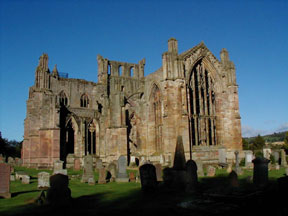 The tide tables are posted and warning signs fill the road. I can only imagine that some fool tried to race Mother Nature and lost. We then had an abbey filled trip to Melrose. The abbeys are in various states of ruin but make for great photos and lots of history lessons on the importance of religion in medieval times. We had bought a Friends of Historic Scotland pass good for about a hundred historic site entry fees. I guess we are trying to get our money’s worth.
The tide tables are posted and warning signs fill the road. I can only imagine that some fool tried to race Mother Nature and lost. We then had an abbey filled trip to Melrose. The abbeys are in various states of ruin but make for great photos and lots of history lessons on the importance of religion in medieval times. We had bought a Friends of Historic Scotland pass good for about a hundred historic site entry fees. I guess we are trying to get our money’s worth.
The last few weeks have been intense…so many different places, famous sites, old ruins. So much history but a lot of it based on wars and greed and religious intolerance. I know that things like buildings can’t last forever, but it was sad to see how much destruction caused by people, not time. It was haunting to drive by castles left to weather in fields…no signs, or visitor centers, or efforts to stay the hand of time. Coming from such a “new “ country as the U.S., it is a strange sight indeed.
Tim reminded me that I needed to put in a few cultural notes so here we go:
French fries here are called chips, while potato chips are called crisps. Chips are served with almost everything:
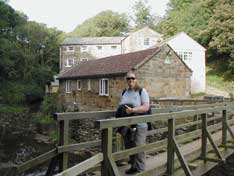 fish and chips (of course), steak and chips, lasagna and chips, Chinese food and chips, macaroni/cheese and chips, etc. I have even seen some people put chips into a bun for a chip sandwich! The crisps can have flavors like Thai chili, salt & pepper, curry, Texas barbeque, and shrimp.
fish and chips (of course), steak and chips, lasagna and chips, Chinese food and chips, macaroni/cheese and chips, etc. I have even seen some people put chips into a bun for a chip sandwich! The crisps can have flavors like Thai chili, salt & pepper, curry, Texas barbeque, and shrimp.
A cottage can be anything from a small home on the beach to a large dwelling in the middle of a city. So if you let (rent) a cottage in a seaside town you may not be able to see the sea.
Carry out food is “take away”, the turning signals on your car are your “side lights”, a “diversion” is a detour, and you don’t yield…you “give way”. While leaving one town I saw “Haste Ye Back” (instead of Come Back Soon).
The names of the towns are a hoot: Sourhope, North Middleton and South Middleton (but no Middle Middleton), Fylingthorpe, Eyemouth, Easter Southlaw, Morebattle (just down from Sourhope), Somersal Herbert, and Sheepy Magna.
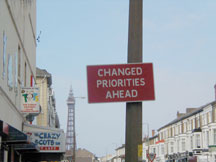 In Aberdeen there is a Springfield Street. It leads you to Springfield Lane, Springfield Road, Avenue, Brae, Circle, Way, and Drive. If I had to deliver the mail there, I think I would just shoot myself.
In Aberdeen there is a Springfield Street. It leads you to Springfield Lane, Springfield Road, Avenue, Brae, Circle, Way, and Drive. If I had to deliver the mail there, I think I would just shoot myself.
If you stay at a bed and breakfast in England, you will be served: juice and/or grapefruit sections, cold cereal with milk, fried egg with bacon, sausage, fried bread, grilled tomatoes and mushrooms, tea or coffee and cold toast with butter and marmalade. If you try to cut back and ask for no meat, they double up the eggs and fried bread. In Scotland it is the same thing except you can have porridge instead of cold cereal and black pudding (a blood sausage) instead of regular sausage. I can’t imagine the cholesterol levels here. And I forgot, it is also common to be served beans (like pork and beans) for breakfast. Some people eat them on toast.
At one restaurant I was given a choice of vegetables: regular canned green peas or mushy peas. If you took canned green peas out of the can and sat on them…that is essentially mushy peas. That veg (veggie) is on many menus, especially with fish and chips. Lots of people eat them, no one knows why.
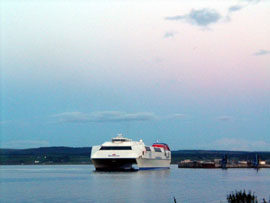
This country also has lots of national competitions. Dog shows, horse shows, flower shows, etc. The towns compete in several categories for the Britain in Bloom awards. My favorite, I think, is the “Loo of the Year” award given to the outstanding public restroom. I know I’ve been to several because the award certificate is framed and proudly displayed within.
Today we are in Stranraer, leaving on the ferry tomorrow for Ireland (Belfast). We don’t know what to expect but since I was raised Catholic and Tim was raised Protestant (and we are wearing no green or orange), we should be okay.
That’s it for now. Hope you are all keeping healthy and happy. More later.
Di and Tim
 This is a nation of walkers. We see all ages walking alone or in groups, some with dogs, some with walking sticks, some bird watching, some looking for fossils, some with maps, and some just ambling along aimlessly. To all of them belong the public footpaths. These are usually marked paths of any distance. The paths, by law, can traverse private land (with permission).
This is a nation of walkers. We see all ages walking alone or in groups, some with dogs, some with walking sticks, some bird watching, some looking for fossils, some with maps, and some just ambling along aimlessly. To all of them belong the public footpaths. These are usually marked paths of any distance. The paths, by law, can traverse private land (with permission).  When a farm or grazing land is involved, there is usually a labeled gate that must be opened and closed or a stile (kind of ladder over a stone fence) that must be climbed. Some paths are shown on maps, others are well marked with wooden signposts, and still others are known only to the locals.
When a farm or grazing land is involved, there is usually a labeled gate that must be opened and closed or a stile (kind of ladder over a stone fence) that must be climbed. Some paths are shown on maps, others are well marked with wooden signposts, and still others are known only to the locals.



 As you walk the promenade you pass endless small casinos, fast food places (fish and chips, not McDonalds), rock candy shops, souvenir shops, and hotels of all sizes. Rock candy, by the way, is a Blackpool favorite. It is a stick of candy about 1 inch in diameter, striped like a candy cane on the outside, with your name or other word through the center of the candy.
As you walk the promenade you pass endless small casinos, fast food places (fish and chips, not McDonalds), rock candy shops, souvenir shops, and hotels of all sizes. Rock candy, by the way, is a Blackpool favorite. It is a stick of candy about 1 inch in diameter, striped like a candy cane on the outside, with your name or other word through the center of the candy.




 The hostel was a ¼ mile walk from the car park (parking lot) but worth every step. It would have been a perfect place to smuggle in goods way back when. At low tide you can walk the beach to the next village. At high tide, it is inaccessible. We then went north to spend Tim’s birthday walking Hadrian’s Wall. This was six foot thick wall with 12 foot ditch on both sides and lookouts built every mile. It marked the border of the Roman Empire and was built to keep the Scottish tribes in the north and the other brigands in the south. Much of the wall was used by locals for building after the Romans left, but there are still parts that go on as far as you can see. The hostel nearby was called Once Brewed, next to the pub called Twice Brewed. They say that a brew is an ancient term for a hill….hmmmm.
The hostel was a ¼ mile walk from the car park (parking lot) but worth every step. It would have been a perfect place to smuggle in goods way back when. At low tide you can walk the beach to the next village. At high tide, it is inaccessible. We then went north to spend Tim’s birthday walking Hadrian’s Wall. This was six foot thick wall with 12 foot ditch on both sides and lookouts built every mile. It marked the border of the Roman Empire and was built to keep the Scottish tribes in the north and the other brigands in the south. Much of the wall was used by locals for building after the Romans left, but there are still parts that go on as far as you can see. The hostel nearby was called Once Brewed, next to the pub called Twice Brewed. They say that a brew is an ancient term for a hill….hmmmm.
 The tide tables are posted and warning signs fill the road. I can only imagine that some fool tried to race Mother Nature and lost. We then had an abbey filled trip to Melrose. The abbeys are in various states of ruin but make for great photos and lots of history lessons on the importance of religion in medieval times. We had bought a Friends of Historic Scotland pass good for about a hundred historic site entry fees. I guess we are trying to get our money’s worth.
The tide tables are posted and warning signs fill the road. I can only imagine that some fool tried to race Mother Nature and lost. We then had an abbey filled trip to Melrose. The abbeys are in various states of ruin but make for great photos and lots of history lessons on the importance of religion in medieval times. We had bought a Friends of Historic Scotland pass good for about a hundred historic site entry fees. I guess we are trying to get our money’s worth.
 fish and chips (of course), steak and chips, lasagna and chips, Chinese food and chips, macaroni/cheese and chips, etc. I have even seen some people put chips into a bun for a chip sandwich! The crisps can have flavors like Thai chili, salt & pepper, curry, Texas barbeque, and shrimp.
fish and chips (of course), steak and chips, lasagna and chips, Chinese food and chips, macaroni/cheese and chips, etc. I have even seen some people put chips into a bun for a chip sandwich! The crisps can have flavors like Thai chili, salt & pepper, curry, Texas barbeque, and shrimp.
 In Aberdeen there is a Springfield Street. It leads you to Springfield Lane, Springfield Road, Avenue, Brae, Circle, Way, and Drive. If I had to deliver the mail there, I think I would just shoot myself.
In Aberdeen there is a Springfield Street. It leads you to Springfield Lane, Springfield Road, Avenue, Brae, Circle, Way, and Drive. If I had to deliver the mail there, I think I would just shoot myself.
